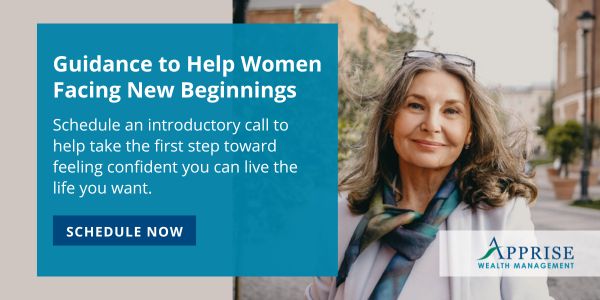Happiness and Success: Use Well-Being as Fuel
Work hard, succeed; then you’ll be happy.
Many of us have heard that formula since we were kids. Is this really the best formula for happiness and success—and for living your most fulfilling life? After all, for women starting fresh—after divorce, widowhood, or an empty nest—waiting on happiness can delay the life you want now.
What if happiness weren’t the prize at the end, but the fuel that helps you get there?
The Science Behind Happiness and Success
Research suggests that positive emotions increase levels of dopamine and serotonin, which in turn support learning, creativity, and resilience. Shawn Achor, author of “The Happiness Advantage,” reports notable uplifts in productivity and decision-making in positive states. His research found that a positive brain is 31% more productive than a brain in a negative, neutral, or stressed state.
- Doctors in a positive state of mind are 19% faster and more accurate in their diagnoses.
- Optimistic salespeople outperform their pessimistic colleagues by 37%.
- Students who feel happy before a math test tend to outperform their peers who feel negative or neutral emotions.
When you’re happier, your brain is more engaged with your work and challenges. That extra lift helps keep stress in check and strengthens the connection between happiness and success, allowing you to stay focused and continue moving toward your goals.
Happy Living
Happiness has wide-ranging benefits beyond productivity. Extensive research, including a meta-analysis of over 225 studies, found that happier individuals are more successful in multiple areas of life, including:
- Relationships: Happier people tend to invest more in connection, and those investments often strengthen relationships.
- Health: Positive emotion correlates with lower stress and healthier behaviors that support longevity.
- Income: Life satisfaction and earnings often move together, as causality can run in both directions.
- Saving: Contentment can reduce impulse spending; pairing it with automatic transfers makes saving stick.
Cultivate Your “Happiness Advantage”
Ready to put happiness first? Try weaving these into your day:
- Practice Gratitude. Jot down three things you’re grateful for. It trains your attention toward positives and builds resilience. I started gratitude journaling a few months ago; it’s reinforced my already optimistic outlook.
- Be Active. If you’re not exercising now, start with 15-20 minutes of daily cardio. Movement clears mental clutter and steadies reactions during stressful periods (like volatile markets). I start virtually every day with exercise for exactly this reason. When I don’t exercise, I miss it.
- Find Purpose. Spend 10 minutes a day on a “why this matters” note before work blocks. Connect tasks to the people you help—clients, team members, and family. At home, be fully present in your most meaningful roles: spouse, parent, friend.
- Invest in Your Relationships. Schedule connection on purpose: a phone-free dinner, a weekly walk-and-talk, a monthly reconnect text, or a planned family getaway.
- Guardrail: Happiness isn’t pretending things are easy; it’s building habits that help you face what’s hard.
If you want help identifying additional ways to invest in your happiness, consider our life-centered planning process. We’ll help you align your finances with what matters most, so you can live more fully, now and in the future.
Ready to align your plan with what matters most? Let’s design a life-centered financial plan based on your values, so happiness and success reinforce each other.👉 Schedule a free Discovery Call today.
This Week’s Favorite Reads:
This week’s Five Favorite Reads dig deeper into positive psychology, resilience habits, and practical ways to weave well-being into everyday money decisions.
You will find articles discussing breaking free from the one more year trap and retiring, ways to nurture your creativity, the true cost of owning a second home, tips for those who want to live to 100, and reasons to consider Continuing Care Retirement Communities sooner than you might think.
Here are the links to this week’s articles, as well as a brief description of each and why you should check it out:
1. How to Break Free From the ‘One More Year’ Trap and Actually Retire.
Many workers fall into the “one more year” trap despite having enough to retire because work provides identity, purpose, status, structure, and social connection. Pew data show 66.9% of people aged 65–74 are retired versus 17.1% of those aged 55–64, as people work longer despite rising wealth. Fears of boredom, irrelevance, market downturns, and health costs persist—even with sizable savings. To break the cycle: build a retirement income plan, define a new purpose, strengthen social ties, create a routine, test retirement via phased or part-time work, stay active, and reassess lifestyle and spending. Bottom line: align money with meaning.
2. 7 Ways to Nurture Your Creativity Now.
Creativity isn’t a luxury. It’s a human default that boosts flexible thinking, problem-solving, and well-being. Our capacity for creativity shouldn’t stop as we age, either. This article shares seven practical ways to unlock it now: 1) work with your hands for 20 minutes to awaken the imagination network; 2) practice mindfulness to calm the nervous system and invite ideas; 3) seek awe in nature; 4) move your body to clear stress and spark endorphins; 5) pursue novel experiences to break ruts; 6) play for its own sake to free the mind; and 7) schedule an “art day” for inspiration. These habits nudge you into flow—where dopamine rises, time softens, joy returns.
3. The True Cost of Owning a Second Home: What to Consider Before You Buy A Vacation Home.
It’s not unusual for clients to consider purchasing either a vacation home or a rental property as part of their financial plan. After all, a second home can be an excellent retreat or future retirement base, but costs are easy to underestimate. Tighter lending standards and larger down payments will likely be required. Insurance is typically higher, especially in coastal or disaster-prone areas. Renting may also require landlord or short-term rental policies. Taxes add complexity: property taxes always apply, and mortgage-interest deductions and reporting depend on whether—and how much—the property is rented out or used personally. Ongoing expenses include utilities, HOA dues, repairs, lawn/pool care, furnishings, and, if renting, cleaning or property management. Bottom line: weigh convenience and potential equity against year-round costs and oversight, and ensure the purchase aligns with your cash flow, risk tolerance, and long-term plans.
4. If You Want to Live to 100, Being Stubborn Helps.
Longevity isn’t just about diet and exercise—it’s also about mindset. Research from UC San Diego and La Sapienza on nonagenarians and centenarians in Italy’s Cilento region finds common traits: accepting setbacks, a positive outlook, and even healthy stubbornness. Lifestyle still matters—whole foods, daily movement, and strong ties to family, faith, and place—but genes explain at most ~25% of lifespan. Studies cited note that later retirement is associated with a lower risk of dementia, and robust social connections can significantly reduce mortality risk. Actions to consider: cultivate grit and purpose, continue working (whether paid or unpaid), and prioritize regular contact with the people you love. Regardless of your age, you can still adopt a life-extending mindset.
5. Starting Over, if you can. Some decisions are subject to change (I apologize for its length).
When working with clients on their financial plans, where to live and what type of care they want are essential considerations. This article discusses one such option, a Continuing Care Retirement Community (CCRC). The author recounts decades of “aging in place”—accessible remodels, wider doors, and a main-floor bath—that have served him and his wife well through surgeries and recovery. But mobility limits and fraying neighborhood ties led to a pivot: downsizing to a nearby CCRC. The move translates to less space, design trade-offs, and emotional decluttering. However, a bridge loan and the assistance of senior move specialists can ease the transition. His message for 50-somethings: plan the housing side of retirement as seriously as the money. Senior housing is supply-constrained, with waitlists that can stretch for years. Get on lists early (with low refundable fees and fixed priority numbers; choose active/inactive and say “no” until it’s right). Bottom line: protect options and community—reserve now.
Our practice continues to benefit from referrals from our clients and friends. Thank you for your trust and confidence.
If you would like to discuss financial topics, including navigating new beginnings, managing your investments, creating a life plan, or saving for retirement, please complete our contact form or schedule a call or a virtual meeting via Zoom. We will be in touch.
Follow us:
Please note. We post information about articles that can help you make better money-related decisions on LinkedIn and Facebook.
For firm disclosures, see here: https://apprisewealth.com/disclosures/




